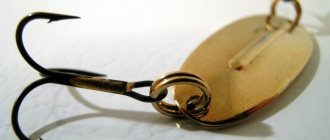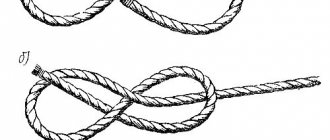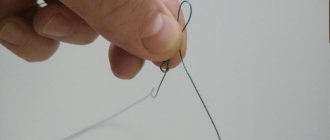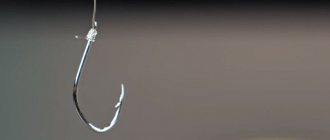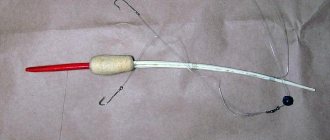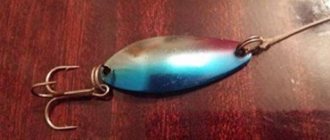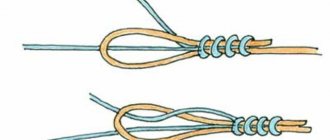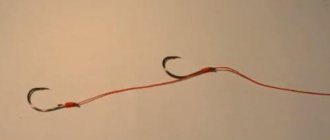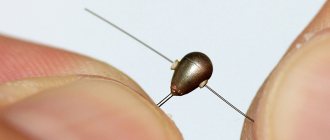Why do you need a shock leader in a snap-in?
This does not mean at all that trophy fish are caught only from distant points, because at night and in the morning they come to the shore to feast on insects falling from the branches of trees and bushes. But general trends indicate that fishing at long ranges is more effective, and anglers choose equipment that facilitates comfortable long-distance casting of gear.
To perform long throws you need:
- powerful rod;
- thin fishing line;
- balanced equipment.
If everything is clear with the rod and equipment, then choosing a fishing line for long-distance fishing presents a certain difficulty, because it must be thin, but also strong, capable of withstanding serious overloads during casting with a powerful blank.
The optimal line diameter for carp gear is considered to be 0.22–0.25 mm, and every extra millimeter of thickness “steals” several meters of distance when casting hard. Manufacturers of fishing equipment and fishing lines in particular are constantly improving their products, improving their quality and increasing strength.
But still, this is not enough to be sure that a fishing line with a diameter of 0.22 mm will withstand overloads when casting, of which there are many in fishing, and the “fatigue” of the material does not add reliability to the equipment.
A solution to the problem was found by fans of surf casting, and they were the first to use shock leaders to prevent equipment breaks during power casting.
These leaders are now using:
- carp fishermen;
- fans of feeder fishing;
- spinners;
- floaters when fishing with match gear.
The name shock leader itself speaks volumes about the purpose of this equipment component, designed to compensate for loads during peak periods, during casting and in the last meters when fishing for a trophy.
What are the requirements for a shock leader?
The shock leader is knitted in order to:
- take on extra loads when casting;
- compensate for the force pressure on the thin main line;
- save the main line when fishing on a difficult bottom, with shells and debris;
- additionally disguise the equipment;
- compensate for the jerks of large fish when introduced into the landing net.
The strength of the shock leader is determined, among other things, by the weight of the equipment being thrown and the thickness of the main fishing line, so there is no strict recommendation regarding the choice of this element of equipment.
Even if we take into account that the feeder rod has a flexible whip (quivertip) and when casting, the load on the main line is less, when fishing at long ranges, feeders also use shock leaders made of durable braided line.
Important!!! The strength of the shock leader is always higher than the strength of the main line.
What are shock leaders?
Materials for making shocks are:
- small diameter braided cord;
- a piece of thick monofilament;
- a piece of fluorocarbon fishing line.
The market also offers ready-made shock leaders made from conical monofilament, which have high strength and minimal elongation. The following combinations of base and shock leader are possible:
- monofilament base – shock braided cord;
- base braided cord - shock thick monofilament;
- the base cord is a shock cord of greater strength;
- monofilament base – shock is also monofilament, but thicker than the base.
How to connect a shock leader to the main line - what knots to tie, step-by-step instructions
Every fisherman can easily master the technique of tying a shock leader by performing step-by-step actions:
- There is a small loop at the end.
- A reliable shock leader is secured for her with a simple clinch.
- Before the control tightening of the knot, do not forget to wet the fishing line to avoid injury.
How to choose a shock for fishing
When choosing a shock leader for bottom fishing, focus on:
- fishing distance;
- features of the bottom of the reservoir;
- equipment weight.
Braided shock leader
Most often, a braided cord is used as a shock, which has high strength and reliability, especially compared to conventional fishing lines. The thickness of the cord is less than monofilament, but the same strength, which provides advantages when camouflaging equipment.
Feeder rigs are tied onto a braided shock leader and it is important that it is unnoticeable in the water. The braided cord does not stretch and with a powerful force cast of the tackle it retains its physical characteristics.
Thanks to the use of a braided shock, a thin main monofilament line creates minimal resistance in the water during the current and less sail when casting. But at the same time, the low stretchability of the braided cord does not allow it to dampen the jerks of the fish when playing, and this disadvantage is compensated for by using a shock made from stretchable monofilament.
Experienced fishermen recommend that when choosing braid for a shock leader, you should focus not on the diameter, but on the breaking load, because these parameters often differ between different manufacturers.
So, the advantages of a braided shock:
- high strength;
- effectiveness of use when fishing at a considerable distance;
- small diameter.
Disadvantages of braided shock:
- slight stretchability, which is important when fishing for trophies;
- the possibility of fish gathering near the shore;
- low abrasion resistance;
- high price.
Important!!! To make a shock, choose sinking braided cords marked Sinking on the reel. Cheap braided fishing line for a shock leader will fray, and its camouflage qualities will be significantly reduced.
Monofilament and fluorocarbon
The abrasive characteristics of the line are low, and when fishing on difficult bottoms, it is recommended to use a leader made of monofilament or fluorocarbon. It turns out that the base in the form of a braided cord is stretched in the water column, and that part of the equipment that comes into contact with the bottom, stones and bottom debris is abrasion-resistant, because this is one of the main advantages of fluorocarbon.
If the equipment gets caught on an obstacle at the bottom of the reservoir, a strong shock will ensure the safety of the equipment and only the leash tied from a thin fishing line will break. In addition to the fact that a monofilament shock has stretchability, it is also convenient for feeders because it glides better over the rings when casting.
On feeders, the guides are smaller than on carp rods, and this factor plays an important role, especially when performing power casting.
Colorless monofilament, and even more so fluorocarbon, have high camouflage characteristics and do not scare away fish from the feeder and hook with nozzle. Small fish are not too shy, but large trophies are much more cautious and distrustful of unusual objects, so when catching them, camouflage is important.
Another advantage of thick monofilament is that when casting forcefully, it does not cut the angler’s finger and a finger guard is not needed.
Advantages of a monoleader:
- availability of materials;
- low cost;
- smoothness, providing better “reach” of the equipment;
- high abrasion resistance;
- the ability to dampen fish jerks when fishing;
- convenience when casting gear.
Flaws:
- less strength than braided line - you need to take a thick fishing line;
- difficulty in binding;
- It is difficult to throw a tackle with a monoleader at an ultra-long distance;
- due to the thickness of the fishing line, the knot with the base turns out to be large and “hits” the rod rings when flying out.
Shock leaders made of fluorocarbon fishing line have virtually no disadvantages, they are invisible in the water, abrasion-resistant and have high strength and rigidity. But high-quality fluorocarbon materials are expensive and this is the reason why few anglers use them.
Important!!! It makes sense to use a monoleader when fishing at a distance of up to 120 meters.
European manufacturers, such as, for example, Preston, produce ready-made shock leaders that have advantages over monofilament and fluorocarbon. Ready-made shock leaders are made in the shape of a cone, and if in the place where the equipment will be tied, their thickness is 0.32 mm, then at the point of connection with the main fishing line, the diameter is already 0.20 mm.
The conical shape of the shock contributes to better “flight” of the line when casting, and therefore to long-distance casts. The length of the finished shock is 15 m, this is enough to ensure safety when casting and reliability of the tackle.
Length
It is recommended to make a shock leader twice the length of the rod, but since in feeder fishing the rig is tied directly on the shock, it is necessary to make a reserve of 2-3 meters. If fishing is carried out with a rod 13 feet (3.9 meters) long, the shock is made 10-11, or even 12 meters. This length allows you to cut off a piece of the leader with the used equipment and not tie it up for the next fishing trip.
It turns out that several turns of the leader are wound on the reel spool, and it takes on the entire load when casting. When fishing, reeling the tackle to the shock leader, the angler must be more careful, but if a couple of turns of the shock are already wound on the reel, there is complete confidence that the fish will end up in the landing net.
Thickness and breaking load
As already mentioned, professionals focus on the breaking load, and not the thickness of the shock, and make their choice based on this criterion. Standard recommendations are for every ounce of load weight to provide 8-10 pounds of breaking load. For a load of 5 ounces, a shock of 40-50 Lb is chosen, but this is the case when ultra-long casts are expected. For regular fishing, shocks with a breaking load of 25-35 Lb (pounds) are used, and this is enough even for large fish.
Methods of tying to the main line
The basic rule for tying knots for a shock leader is the minimum loop size. It should not cling to the rod guides and artificially reduce the line speed when casting. The required fastening reliability is also ensured. Simple but effective knots have been developed for tying.
Carrot
The shock leader knot got its name because of its conical shape. It has sufficient reliability and is characterized by ease of formation. For a fishing carrot knot, you need to leave about 5 cm of free ends. If you follow the knitting rules, it will pass through the rings well.
Stages of connection formation:
- At the end of the shock and the fishing line, two knots are tied, the distance between them is up to 3 cm.
- The main cord makes about 5-7 turns around the leader.
- The same procedure is performed in the opposite direction.
- The end of the fishing line is threaded through the shock loop.
- Wetting the connection and tightening.
The ends are not cut to fit the base. Small segments, up to 2 cm, will glide along the water surface and increase the casting distance. The carrot knot for a shock leader has one advantage - ease of learning.
Albright
This knitting technique is ideal for thin monofilament. The final connection is small, the ends will be directed along the braid. Important - using a thick shock will make the knitting procedure labor-intensive.
Execution order:
- We bend the end of the leader so that a loop is formed. The length of the curved end is up to 10 cm.
- We pass the braiding at a distance of up to 20 cm.
- We make about ten turns with the main line around the shock and the rest of the braid.
- After this, the remaining end is passed into the loop and five more turns are formed.
- The final tie of ends.
- Wetting and tightening.
You can master this technology relatively quickly. It is important to choose the right leader for a specific equipment and calculate its length.
zhyvoi.ru
Knots for tying shock leader
The knot for tying the shock leader is made as small as possible, so that it slips freely in the rod guides when casting the tackle. Carp rods have larger rings than feeder rods, so the correct knot is especially important in feeder fishing.
To knit a shock leader, it is recommended to use knots:
- carrot (Mahin knot);
- double grinner;
- Albright;
- bloody knot.
There are other knots used to knit leaders (for example, the Minenko knot), but the most common are those listed above. A novice fisherman should pay special attention to learning how to properly tie a shock leader to a fishing line, because comfort when casting and the safety of the equipment depend on this.
If the knot does not pass freely in the rings, a successful cast, especially over a long distance, will be difficult, if not impossible. Most often, pieces of old thick fishing line or laces are used for training, providing the necessary convenience.
Carrot knot for leader
The name of this knot is due to its external similarity to the famous vegetable, and the advantage is that both tails of the tied materials are directed in the direction opposite to the direction of throwing the tackle. When casting, such a knot does not cling to the rings and, thanks to its streamlined shape, freely skips through difficult areas. The correct carrot knot has a cone shape and small size, which is especially important in feeder fishing.
To make a carrot knot you need:
- make a regular knot on the shock leader;
- insert the warp into the knot formed with a margin of 30 cm;
- wrap the main fishing line around the shock leader, 10 turns in one direction and fixing the twist with your fingers, 10 in the other direction;
- thread the end of the fishing line into the shock leader knot;
- tighten the shock knot;
- moisten the twist and tighten it, holding both ends of the fishing line;
- trim the ends of the fishing line and shock;
- glue the knot with fishing glue.
The strength of the carrot knot is 100%, and it is considered the most reliable. Carrots are used for knitting any variants of warp and shock leader materials.
Double Grinner
To tie monofilament and braided fishing line, it is convenient to use a double-grinner knot, which is characterized by its small size and high strength. The difference in the thickness of the materials being bonded should be no more than 1/5.
To knit a double grinner you need:
- the materials are laid overlapping and ends 25-30 cm long are left;
- at the junction of the materials, a loop is made from one of them, which is clamped with your fingers;
- the free end of the loop is wrapped around both materials (5 turns);
- holding the ends, the knot is tightened;
- the same manipulations are performed with the second material;
- the knot is wetted and tightened;
- the resulting nodes are pulled together like a noose;
- the free ends are trimmed (1.5-2 mm remains).
Unlike the carrot, the double-grinner has the ends of the lines pointing in different directions and after numerous casts the knot becomes frayed. Therefore, it should be glued in order to ensure the necessary reliability.
Albright node
Albright is used by fly fishers, because this unit is compact and reliable; it binds materials with a difference in diameter of more than 1/3.
To make the Albright knot you need:
- a loop 10 cm long is formed from thicker material;
- thin material is threaded into the loop with a tolerance of 20 cm;
- at the point of intersection of the materials, they are pinched with your fingers, and the thin material is made 10 turns around the loop in the opposite direction;
- the end of the thin material is threaded through the loop again and tightened;
- excess ends are cut off (1.5-2 mm remains);
- the knot is glued.
Albright is the narrowest knot that fits freely into small rod rings, and is actively used in feeder fishing.
Blood knot
The bloody knot is used when tying materials with a difference in diameters of 1/3. This is an inconspicuous knot and its strength is 87%. How to tie a bloody knot:
- the materials are overlapped, and the length of the free ends is 15-20cm;
- at the intersection, the materials are fixed with fingers, and one of them is wrapped around the other (5 turns);
- the remaining end of the material returns to the junction and a loop is formed;
- the second material is wrapped around the first (5 turns);
- the free end of the second material is threaded into the loop and the knot is tightened;
- free ends are cut off;
- the knot is glued.
If knots are tied right on the shore of a reservoir, it is not always possible to glue them. Therefore, after several casts, you should check the condition of the unit and make sure that it is strong and reliable.
Important!!! Knots should be wetted before tightening. It is advisable to glue the knots with fishing glue.
There is no universal material for making a shock leader; each of those used has both advantages and disadvantages. Therefore, when making a choice, fishermen are guided by the existing conditions, the assigned tasks, as well as the expected size of the fish in the catch.
Correct installation on the reel
Knowing what it is and choosing the right model, you can begin installation. First, the length of the segment is determined. According to some sources, it should be fixed - up to 10 m. But experienced fishermen use a different calculation principle - two spinning rod lengths. This is the maximum length of line during a strong swing. After covering a certain distance, the load drops sharply - you can use the main braid.
Tackle for and methods of pike fishing: spinning, mugs, girders, jig
After measuring, you need to tie an additional segment according to the following scheme.
- The main line is wound onto the reel.
- An additional one is fixed with knots, it unwinds to the end of the rod and from there again to the reel.
- The excess leader is trimmed.
- Attachment equipment is installed.
Since you can tie the shock leader to the main fishing line directly while fishing, it is recommended to prepare all the components in advance. Beginning fishermen can do these steps at home. This is necessary to develop a skill. Additionally, you should check the strength of the fastening by making several casts in open areas.
In the video instructions, an experienced fisherman will explain the nuances of using a shock and clearly show the stages of tying:
